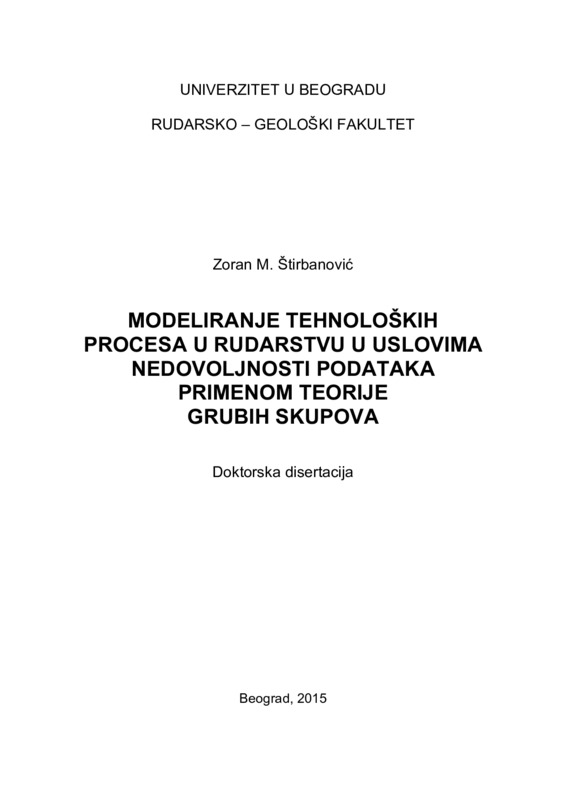Modeliranje tehnoloških procesa u rudarstvu u uslovima nedovoljnosti podataka primenom teorije grubih skupova
Објеката
- Ментор
- Igor Miljanović
- Члан комисије
- Zoran Gligorić|Zoran Marković
- Креатор
- Zoran M. Štirbanović
- Датум издавања
- 2015-07-01
- Сажетак
- Rudarstvo, a u okviru njega i priprema mineralnih sirovina, se odlikuje složenošću tehnoloških procesa što je posledica velikog broja uticajnih parametara. Samim tim je potrebno biti veoma obazriv prilikom donošenja odluka u oblasti rudarstva. U cilju što efikasnijeg funkcionisanja procesa, moguće je primeniti različite metode koje služe za pojednostavljenje procesa odlučivanja. Jedna od takvih metoda jeste i teorija grubih skupova. Ona predstavlja relativno novu matematičku teoriju koja je pogodna za razumevanje nepreciznih i nepotpunih podataka kao i za otkrivanje međusobnih odnosa između tih podataka.Teorija grubih skupova je pronašla primenu u različitim granama industrije, međutim pregledom literature došlo se do zaključka da primenjivost ove teorije u rudarstvu nije dovoljno ispitana. To je bila polazna osnova doktorske disertacije, ispitivanje mogućnosti njene primene u oblasti rudarstva.U okviru eksperimentalnog dela disertacije izvršeno je testiranje mogućnosti primene teorije grubih skupova za rešavanje tri problema: izbor lokacije za flotacijsko jalovište, izbor flotacijskog kolektora i izbor flotacione mašine. Određeni su parametri koji imaju najviše uticaja prilikom ova tri izbora, odnosno određeni su kriterijumi za izbor. Izabranim kriterijumima su dodeljene odgovarajuće vrednosti, a nakon toga je izvršeno vrednovanje predloženih subjekata. Na taj način je izvršena primena teorije grubih skupova za rešavanje datih problema. Na kraju, nakon analize primenom teorije grubih skupova, izvršena je provera dobijenih rezultata metodama višekriterijumskog odlučivanja: VIKOR, AHP, ELECTRE, PROMETHEE i TOPSIS.Na osnovu dobijenih rezultata se došlo do zaključka da je u sva tri problema uspešno primenjena teorija grubih skupova. Poklapanje rezultata dobijenih metodom grubih skupova sa rezultatima dobijenim ostalim metoda višekriterijumskog odlučivanja se kreće od 100% poklapanja u slučaju izbora lokacije za flotacijsko jalovište, do 40% u slučaju izbora flotacijskog kolektora i flotacione mašine. Visoki koeficijenti korelacija demonstriraju visoku osetljivost metode grubih skupova u uslovima višekriterijumskog odlučivanja i determinišu njenu upotrebljivost u uslovima nedovoljnosti podataka.
- Mining, and mineral processing within it, is characterized by the complexity of the technological process due to the large number of influential parameters. Therefore it is necessary to be very cautious when making decisions in the field of mining. In order to provide a more efficient functioning of the processes, it is possible to apply methods that are used to streamline the decision-making process. One such method is the rough set theory. It is a relatively new mathematical theory that is suitable for understanding imprecise and incomplete data as well as to detect relationships between these data.The rough set theory has found application in various areas of industry, however, by reviewing literature it was concluded that the applicability of this theory in mining has not been sufficiently investigated. This was the starting point of a doctoral dissertation, examining the possibilities of its application in mining.In the experimental part of the dissertation was done testing the possibilities for application of rough set theory to solve three problems: choosing location for the flotation tailings landfill, choosing flotation collector and choosing flotation machine. The parameters that have the most influence during these three choices were determined, and they represented criteria for selection. The selected criteria were assigned with appropriate value, and subsequently the evaluation of the proposed subjects was carried out. In this way, rough set theory was applied for solving the given problems. Finally, results obtained by rough set theory, were verified by multi-criteria decision-making methods: VIKOR, AHP, ELECTRE, PROMETHEE and TOPSIS.Based on results it was concluded that rough set theory was successfully applied in all three problems. The superposition of the results obtained by the rough set theory with the results from other multi-criteria decision-making methods varies from 100% in the case of the choosing location for the flotation tailings landfill, to 40% in the case of choosing flotation collectors and flotation machines. High correlation coefficients demonstrate the high sensitivity of the rough set theory in terms of multi-criteria decision-making and define its usefulness in terms of insufficiency of data.
- Формат
- application/pdf
- Језик
- sr
- Издавач
- Универзитет у Београду, Рударско-геолошки факултет
- Права
- Autorstvo-Nekomercijalno 3.0 Srbija (CC BY-NC 3.0)
- Извор
- Универзитет у Београду
- Subject
- rudarstvo, priprema mineralnih sirovina, teorija grubih skupova, višekriterijumsko odlučivanje, flotacijsko jalovište, flotacijski kolektor, flotaciona mašina
- mining, mineral procesing, rough set theory, multi-criteria decision-making, flotation tailings landfill, flotation collector, flotation machine
- Тип
- Докторска дисертација
Zoran M. Štirbanović. "Modeliranje tehnoloških procesa u rudarstvu u uslovima nedovoljnosti podataka primenom teorije grubih skupova" in Универзитет у Београду, Универзитет у Београду, Рударско-геолошки факултет (2015-07-01)

